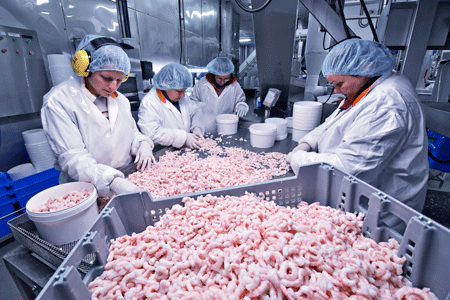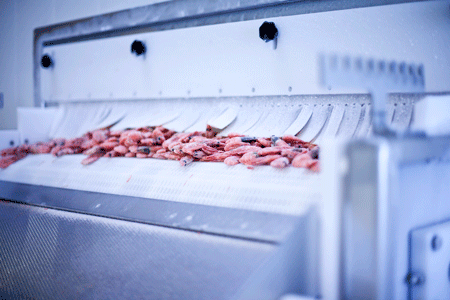Salt is currently used to preserve all kinds of fish products as it reduces bacterial growth and improves shelf life. We are consuming too much salt, however, so food producers need to find new ways to preserve prawns, salmon and roe.
Cold-smoked fish, lumpfish roe and prawns in brine—Danish consumers love lightly preserved fish products. And specialist producers including Royal Greenland are among the best in the world at preparing salted, smoked and marinated fish products.
In the same way as other sectors, however, fish producers are encountering new requirements on health, safety and taste from consumers and public authorities alike. One focus area that is currently attracting a great deal of attention in Denmark and internationally is the desire to reduce the content of what is known as ‘hidden salt’ in foods. This is because consuming large volumes of salt can adversely affect the body’s natural salt balance, potentially leading to raised blood pressure and the associated risk of cardiovascular disease.
When salt equals food safety
But what are producers to do when salt is used as a preservative, playing a key role in food safety? DTU and Royal Greenland have teamed up to develop a tool that makes it simple and straightforward to predict how bacterial growth will develop in lightly preserved fish products—such as prawns in brine—if adjustments are made to up to 12 different parameters including salt level, temperature and pH value in a production process.
“The new tool is absolutely brilliant. This model helps us to save both time and money when we’re working to develop new products,” relates Niels Bøknæs, Process Developer at Royal Greenland, which employs more than 2,000 people and generates an annual turnover in excess of DKK 5 billion.
“Whereas we previously had to carry out protracted trials if we wanted to reduce the salt content in a product, for example, we can now simply switch on the computer and enter the new data. The model presents a quick, clear and reliable impression of what the new salt levels will mean with regard to unwanted growth of hazardous bacteria, and thus for the shelf life and safety profile of the new product. Simply put, it significantly cuts our product development timeline,” he explains.
Out with the lethal bacteria
The model has been developed to predict factors such as the growth of the potentially deadly listeria bacteria. Listeria is a family of bacteria comprising ten species that can appear in meat, fish and dairy products, as well as in raw vegetables. The type of bacteria that can infect people is called Listeria monocytogenes. If infected, people in the risk group face a mortality rate of close to 20 per cent, so the issue is one that the food industry takes very seriously indeed.
 |
|
Thanks to in-depth knowledge about bacteria, years of work in the laboratory and advanced mathematical models, Royal Greenland is now in a position to reduce the salt content of its prawns in brine.
|
Six thousand users
The new tool has been named the Food Spoilage and Safety Predictor (FSSP). It is one of the biggest and best of its kind in the world, and it is freely available on DTU’s servers. The program, which is free to use, has already attracted around 6,000 users in 100 countries.
While the program was originally developed for fish products, DTU researchers discovered that the tool was also being used in the meat industry. They therefore conducted new trials in the run-up to the latest update, and proved that it is suitable for use with both meat and fish.
 |
|
Royal Greenland in figures:
- Net turnover: DKK 5,312 million (2012/13)
- Number of employees: 2,000
- Number of production facilities in Greenland: 24
- Number of production facilities outside Greenland: 6
- In 2012/13, the group’s vessels fished 35,900 tonnes in Greenland and the North Atlantic, including 24,677 tonnes of prawns.
- Royal Greenland is owned by the Government of Greenland.
|
Article from DYNAMO no. 38, DTU's quarterly magazine .
- The average daily salt intake in Denmark is 9–11 g among men and 7–8 g among women.
- The official recommended intake is 5–6 g for both women and men. The human body does not need more than 1.5 g of salt per day.
- Most of the salt we consume comes from refined foods such as bread, meat products and ready meals. We add less than 20 per cent of the salt ourselves.
- Eating less salt helps reduce blood pressure, and, as a result, probably helps cut the risk of cardiovascular disease. High salt consumption is also a suspected risk factor for certain types of cancer.
- It is estimated that reducing salt consumption by 3 g per day would prevent at least 1,300 deaths from cardiovascular illness in Denmark annually.
Source: DTU Food